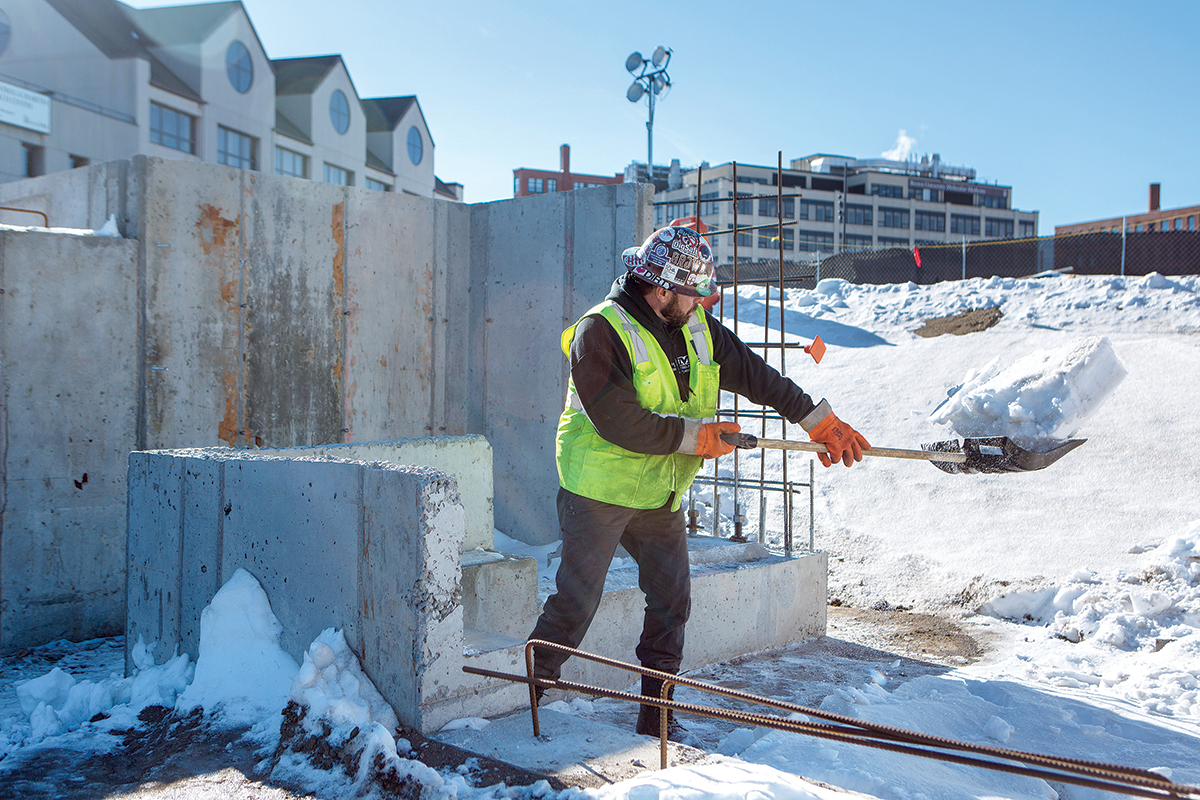As snow fell on Providence during the first significant storm of the winter, a construction worker in a bright orange lift toiled on windows on a science and technology addition at Lincoln School.
Within days, as temperatures plunged, workers piled on the layers at construction sites around the state, and kept going.
There was a time when snow or below-freezing temperatures brought heavy construction to a stop, particularly on projects that had yet to be enclosed. No more. The all-season construction industry is in full public view across Rhode Island, as projects with set completion dates move forward.
Mike Sanchez, chief of construction operations for Shawmut Design and Construction, said the winter storm that struck the Northeast in early January disrupted most of the Boston-based company’s work sites, but only temporarily.
“A lot more projects stopped 30 years ago than today,” he said, of the impact of winter weather. “With the new technologies that are in place, and different practices that we use, construction is pretty much a 12-month-a-year [effort].”
That doesn’t mean it’s easy, or inexpensive. All the budgets and estimates for projects that feature a winter component consider the cost of industrial heaters, heavy, insulated tarps to block open windows or to fully wrap a building, and additional time for worker breaks.
Some changes in techniques and materials also have allowed work to press on. Concrete can be set at lower temperatures with additives. Portable, industrial heaters allow workers to continue their work in buildings without heavy gloves.
Bond, which has offices in Providence, will on occasion set a building foundation in ground that has already frozen. The process involves soaking the soil with hot water, and covering the project site with blankets. It’s expensive, due to the labor involved, according to regional manager Dan Ramos.
Winter undoubtedly makes construction more difficult and more expensive, he said.
But because many of the Bond projects involve construction for universities and colleges, they have a schedule that is grouped around the academic year. Typically, they start immediately after commencement ceremonies.
“You want to get your building [weather]-tight by Thanksgiving or Christmas,” he said, “so you’re not fighting the cold temperatures.”
One of the trickiest elements of winter construction is masonry, such as application of brick. The masonry won’t set under a certain temperature, and the work site must be kept heated.
‘Construction is pretty much a 12-month-a-year [effort].’
MIKE SANCHEZ, Shawmut Design and Construction chief of construction operations
The company is building an addition and expansion of a science building at Providence College this year, and has created a system of scaffolding and fire-rated tarps around the exterior to keep the work area warm enough for work to continue on a granite and brick façade.
One of the best tools for a construction manager is a strong sense of scheduling.
Sanchez still remembers the snarky comment he got in Boston, when he went to get a fire permit to allow an open flame on the commercial heater, after the temperature plunged quickly on a work site years ago.
He was told he couldn’t get the permit that day. The permit officer put it bluntly: “Winter comes the same time every year. Plan accordingly.”
Shawmut, which has a Providence office, this year has several projects in Rhode Island, including the Lincoln School science and technology addition, as well as the new River House apartments, under construction as part of the South Street Landing complex in Providence.
Time pressure to keep projects moving is intense. Every project has an end date. By the time construction has begun on a site, the owner is making plans for leasing or filling the space.
Contracts set completion dates, and the construction is scheduled to meet them. If the truly unexpected snow or cold event disrupts that schedule, an accommodation can be made.
For Bond, the early January storm resulted in a daylong work stoppage on its sites. For obvious reasons, worker safety becomes an issue, in part just due to their transportation to and from the buildings, Ramos said.
But the expectation is that, within reason, work continues.
“There are limitations to everything,” Sanchez said. “So, structural steel erection, for example. It’s not really a temperature-dependent issue for the materials. It becomes a safety factor for our workers. If they have to wear so many clothes to stay warm, or they can’t get the production because they’re walking around like the Michelin Tire [Man], sometimes logic has to play into things.”













